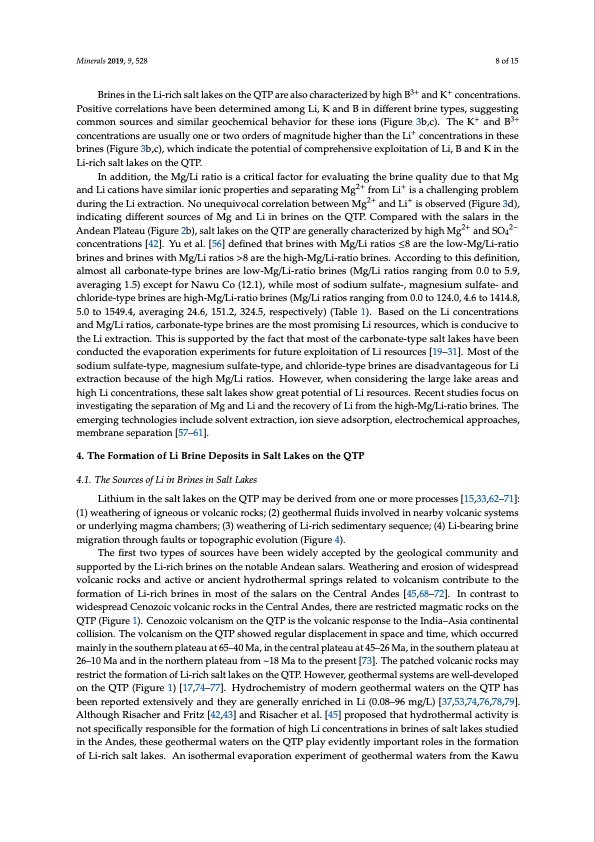
PDF Publication Title:
Text from PDF Page: 008
Minerals 2019, 9, 528 8 of 15 Brines in the Li-rich salt lakes on the QTP are also characterized by high B3+ and K+ concentrations. Positive correlations have been determined among Li, K and B in different brine types, suggesting common sources and similar geochemical behavior for these ions (Figure 3b,c). The K+ and B3+ concentrations are usually one or two orders of magnitude higher than the Li+ concentrations in these brines (Figure 3b,c), which indicate the potential of comprehensive exploitation of Li, B and K in the Li-rich salt lakes on the QTP. In addition, the Mg/Li ratio is a critical factor for evaluating the brine quality due to that Mg and Li cations have similar ionic properties and separating Mg2+ from Li+ is a challenging problem during the Li extraction. No unequivocal correlation between Mg2+ and Li+ is observed (Figure 3d), indicating different sources of Mg and Li in brines on the QTP. Compared with the salars in the Andean Plateau (Figure 2b), salt lakes on the QTP are generally characterized by high Mg2+ and SO42− concentrations [42]. Yu et al. [56] defined that brines with Mg/Li ratios ≤8 are the low-Mg/Li-ratio brines and brines with Mg/Li ratios >8 are the high-Mg/Li-ratio brines. According to this definition, almost all carbonate-type brines are low-Mg/Li-ratio brines (Mg/Li ratios ranging from 0.0 to 5.9, averaging 1.5) except for Nawu Co (12.1), while most of sodium sulfate-, magnesium sulfate- and chloride-type brines are high-Mg/Li-ratio brines (Mg/Li ratios ranging from 0.0 to 124.0, 4.6 to 1414.8, 5.0 to 1549.4, averaging 24.6, 151.2, 324.5, respectively) (Table 1). Based on the Li concentrations and Mg/Li ratios, carbonate-type brines are the most promising Li resources, which is conducive to the Li extraction. This is supported by the fact that most of the carbonate-type salt lakes have been conducted the evaporation experiments for future exploitation of Li resources [19–31]. Most of the sodium sulfate-type, magnesium sulfate-type, and chloride-type brines are disadvantageous for Li extraction because of the high Mg/Li ratios. However, when considering the large lake areas and high Li concentrations, these salt lakes show great potential of Li resources. Recent studies focus on investigating the separation of Mg and Li and the recovery of Li from the high-Mg/Li-ratio brines. The emerging technologies include solvent extraction, ion sieve adsorption, electrochemical approaches, membrane separation [57–61]. 4. The Formation of Li Brine Deposits in Salt Lakes on the QTP 4.1. The Sources of Li in Brines in Salt Lakes Lithium in the salt lakes on the QTP may be derived from one or more processes [15,33,62–71]: (1) weathering of igneous or volcanic rocks; (2) geothermal fluids involved in nearby volcanic systems or underlying magma chambers; (3) weathering of Li-rich sedimentary sequence; (4) Li-bearing brine migration through faults or topographic evolution (Figure 4). The first two types of sources have been widely accepted by the geological community and supported by the Li-rich brines on the notable Andean salars. Weathering and erosion of widespread volcanic rocks and active or ancient hydrothermal springs related to volcanism contribute to the formation of Li-rich brines in most of the salars on the Central Andes [45,68–72]. In contrast to widespread Cenozoic volcanic rocks in the Central Andes, there are restricted magmatic rocks on the QTP (Figure 1). Cenozoic volcanism on the QTP is the volcanic response to the India–Asia continental collision. The volcanism on the QTP showed regular displacement in space and time, which occurred mainly in the southern plateau at 65–40 Ma, in the central plateau at 45–26 Ma, in the southern plateau at 26–10 Ma and in the northern plateau from ~18 Ma to the present [73]. The patched volcanic rocks may restrict the formation of Li-rich salt lakes on the QTP. However, geothermal systems are well-developed on the QTP (Figure 1) [17,74–77]. Hydrochemistry of modern geothermal waters on the QTP has been reported extensively and they are generally enriched in Li (0.08–96 mg/L) [37,53,74,76,78,79]. Although Risacher and Fritz [42,43] and Risacher et al. [45] proposed that hydrothermal activity is not specifically responsible for the formation of high Li concentrations in brines of salt lakes studied in the Andes, these geothermal waters on the QTP play evidently important roles in the formation of Li-rich salt lakes. An isothermal evaporation experiment of geothermal waters from the KawuPDF Image | Lithium-Rich Brines in Salt Lakes on the Qinghai-Tibetan

PDF Search Title:
Lithium-Rich Brines in Salt Lakes on the Qinghai-TibetanOriginal File Name Searched:
minerals-09-00528.pdfDIY PDF Search: Google It | Yahoo | Bing
Product and Development Focus for Infinity Turbine
ORC Waste Heat Turbine and ORC System Build Plans: All turbine plans are $10,000 each. This allows you to build a system and then consider licensing for production after you have completed and tested a unit.Redox Flow Battery Technology: With the advent of the new USA tax credits for producing and selling batteries ($35/kW) we are focussing on a simple flow battery using shipping containers as the modular electrolyte storage units with tax credits up to $140,000 per system. Our main focus is on the salt battery. This battery can be used for both thermal and electrical storage applications. We call it the Cogeneration Battery or Cogen Battery. One project is converting salt (brine) based water conditioners to simultaneously produce power. In addition, there are many opportunities to extract Lithium from brine (salt lakes, groundwater, and producer water).Salt water or brine are huge sources for lithium. Most of the worlds lithium is acquired from a brine source. It's even in seawater in a low concentration. Brine is also a byproduct of huge powerplants, which can now use that as an electrolyte and a huge flow battery (which allows storage at the source).We welcome any business and equipment inquiries, as well as licensing our turbines for manufacturing.| CONTACT TEL: 608-238-6001 Email: greg@infinityturbine.com | RSS | AMP |